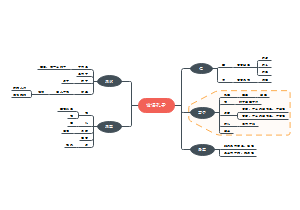导图社区 The Bayesian Network Represent
- 10
- 0
- 0
- 举报
The Bayesian Network Represent
"探索贝叶斯网络的强大表示力!本文从联合分布的实际挑战出发,揭示如何通过图结构捕捉概率依赖关系核心内容分为三部分:1)贝叶斯网络基础,阐释独立性假设与参数优化2)图与分布的映射理论,包括完美映射、最小I图及D分离准则3)分布P与图G的独立性等价性讨论,涵盖完备性与可靠性分析通过两大关键思想,展现概率模型与图论的精妙结合"。
编辑于2025-09-18 10:22:21- 贝叶斯网络表示
- 图与分布独立性
- 完美映射构建
- 概率图模型
- 相似推荐
- 大纲
The Bayesian Network Representation
用所有参数表示联合分布不实际
N个二进制变量联合分布所需要的参数个数为
计算量太大
在统计上,估计这些参数不可能并且所需要的数据量太大
在认知上,这些参数也不符合人类直觉
Two key ideas
the representation of independence properties of the distribution
the use of an alternative parameterization that allows us to exploit these finer-grained independencies
1 Exploiting Independence Properties
Independent Random Variables
The Conditional Parameterization
the conditional representation is more natural than the explicit representation of the joint.
The Naive Bayes Model
2 Bayesian Networks
Bayesian networks build on the same intuitions as the naive Bayes model by exploiting conditional independence properties of the distribution in order to allow a compact and natural representation
Model(from P to G)
a directed acyclic graph (DAG)
nodes: rondom variables
edges: direct influence of one variable on another
This graph G can be viewed in two very dierent ways
a data structure
provides the skeleton for representing a joint distribution compactly in a factorized way;
a compact representation
for a set of conditional independence assumptions about a distribution
these two views are, in a strong sense, equivalent
a set of local probability models
represent the nature of the dependence of each variable on its parents
conditional probability distribution (CPD) for r.v. X given its parents
joint probability
the chain rule for Bayesian networks
Reasoning Patterns
causal reasoning
evidential reasoning
intercausal reasoning
A formal semantics (from G to P)
Basic Independencies
a node depends directly only on its parents
why???
Bayesian network structure
Graphs and Distributions(G == P?)
A distribution P satisfies the local independencies associated with a graph G if and only if P is representable as a set of CPDs associated with the graph G
I-Maps
I-Map to Factorization
every distribution for which G is an I-map must satisfy these assumptions
factorization
Bayesian network
specifies the completeness??
Thm 1
the conditional independencies imply factorization
Factorization to I-Map
Thm 2
Thm1 and Thm2 imply the if and only if above
3 Independencies in Graphs
Are there other independencies that hold for every distribution P that factorizes over G?
D-separation
Direct connection
Indirect connection
Indirect causal effect/Causal trail
X->Z->Y
active if and only if Z is not observed
Indirect evidential effect/Evidential trail
Y->Z->X
active if and only if Z is not observed
Common cause
X<-Z->Y
active if and only if Z is not observed
Common effect/v-structure
X->Z<-Y
active if and only if either Z or one of Z's descendants is observed
The definition of observed variable and active trail
The definition of d-sepertation
global Markov independencies I(G)
Soundness and Completeness
Soundness
the first property we want to ensure for d-separation as a method for determining independence is soundness
if we find that two nodes X and Y are d-separated given some Z, then we are guaranteed that they are, in fact, conditionally independent given Z
Thm 3
i.e. any independence reported by d-separation is satisfied by the underlying distribution.
Completeness
d-separation detects all possible independencies
faithful
Thm 4
this can only conduct from the given G,but if the G cannot reflcets all the dependencies, we cannot deduce that I(P) is the subset of I(G) except faithful is fullfilled
Thm 5
An Algorithm for d-Separation
I-Equivalence
very dierent BN structures can actually be equivalent, in that they encode precisely the same set of conditional independence assertions
The definition of I-equivalent
this is a equivalence relation
any distribution P that can be factorized over one of these graphs can be factorized over the other.
skeleton
definition
but the two networks have the same trails is clearly not enough,such as v-structure
Thm7
attention: this characterization is not an equivalence,this the sufficient condition for I-equivalence
example : complete graph
immorality
definition
Thm8
cover edge
Thm 9
From Distributions to Graphs
Given a distribution P , to what extent can we construct a graph G whose independencies are a reasonable surrogate for the independencies in P?
Minimal I-Maps
definition
how to get it?
Algorithm
notation
G is a minimal I-map for P is far from a guarantee that G captures the independence structure in P
Perfect Maps
definition
find the P-map
Is whether every distribution has a perfect map?NO!
deterministic relationships can lead to distributions that do not have a P-map
A dierent class of examples is not based on structure within a CPD, but rather on symmetric variable-level independencies that are not naturally expressed within a Bayesian network
A second class of distributions that do not have a perfect map are those for which the independence assumptions imposed by the structure of Bayesian networks is simply not appropriate
EXIST, how to find it?
Finding Perfect Maps
one of our tasks in this section is to develop a compact representation of an entire equivalence class of DAGs
1 Identifying the Undirected Skeleton
lemma 1
lemma 2
2 Identifying Immoralities
Proposition 1
Proposition 2
3 Representing Equivalence Classes
the definition of class PDAG
Rules for class PDAG
Thm10
Proposition 3
Proposition 4
Proposition 5
Proposition 6
Proposition 7
Proposition 8









